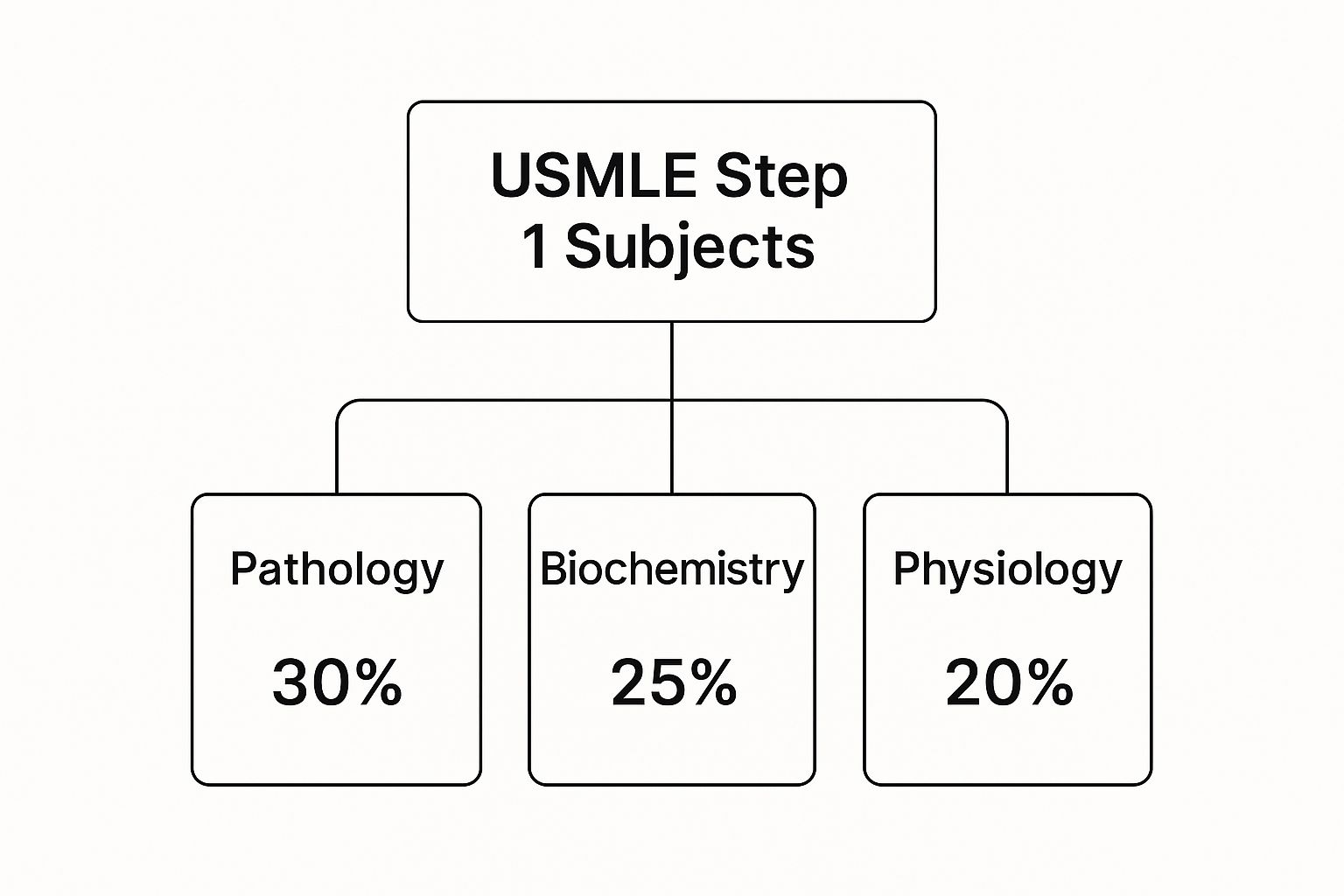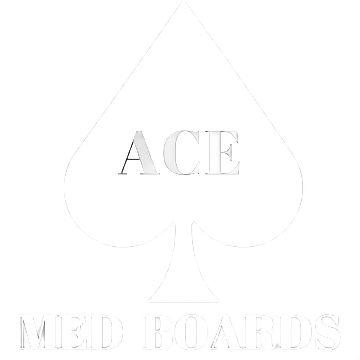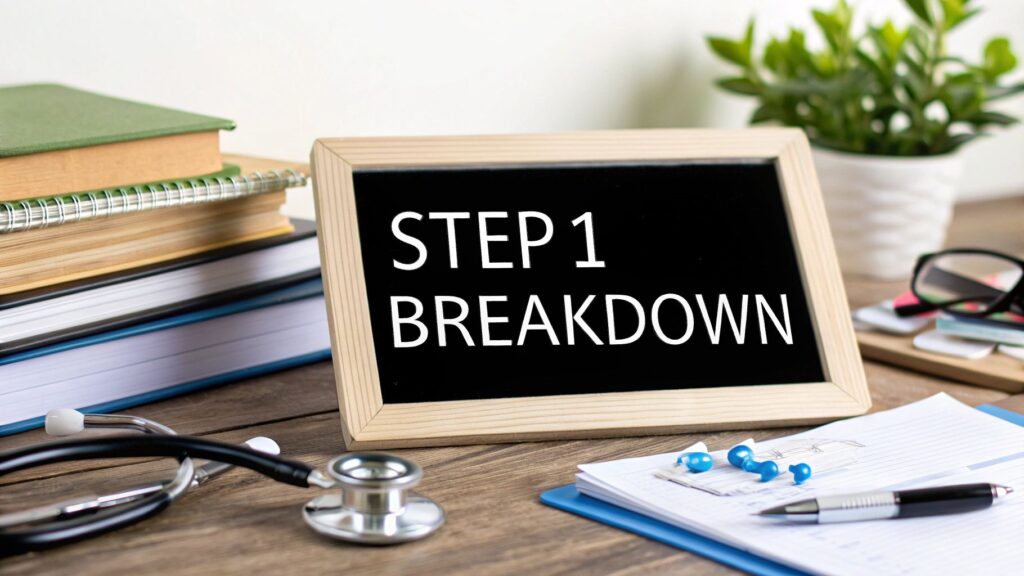Alright, let's break down what you're up against on test day. The USMLE Step 1 is an eight-hour, computer-based beast. It’s broken down into seven 60-minute blocks, and you’ll face up to 280 multiple-choice questions in total. That gives you roughly 90 seconds to dissect and answer each one. This isn't just a knowledge test; it's a grueling marathon that tests your ability to apply foundational science concepts to real-world clinical scenarios.
The USMLE Step 1 Structure at a Glance
Think of exam day as a series of sprints within a much longer race. The whole thing is designed to be an all-day event, demanding serious mental stamina and a smart pacing strategy. Getting a handle on the logistics is your first step toward building the confidence you'll need to walk in and own it.
The entire event spans eight hours, but not all of that is spent staring at questions. A huge part of your day is break time. You're officially allocated 45 minutes for personal breaks, which you can split up however you want between the testing blocks.
Here's a pro tip: there’s an optional 15-minute tutorial at the very beginning of the exam. If you skip it (and you should, since you'll already be familiar with the format), those 15 minutes get added to your break time, giving you a full hour to use throughout the day.
Your Exam Day Blueprint
Knowing the content is only half the battle; properly managing your time and energy is the other half. The structure is fixed, which is great because it lets you build a rock-solid plan. If you want to go deeper into scheduling your prep, our guide on how to create a USMLE Step 1 study plan is packed with valuable insights.
To make it simple, here's a quick summary of what your exam day will look like.
USMLE Step 1 Exam Day at a Glance
| Component | Details |
|---|---|
| Total Test Duration | 8 hours |
| Question Blocks | 7 blocks |
| Questions per Block | Up to 40 questions |
| Time per Block | 60 minutes |
| Total Questions | Up to 280 questions |
| Allocated Break Time | 45 minutes (plus the optional 15-minute tutorial) |
This breakdown really drives home the importance of pacing. Each one-hour block is its own little challenge, and managing your time effectively within each one is absolutely critical. Knowing you have scheduled breaks coming up can be a lifesaver, helping you stay focused and avoid burnout during this incredibly demanding assessment.
Breaking Down the Step 1 Exam Format

To truly build a winning study strategy, you need to look past the high-level stats and understand the real anatomy of the Step 1 exam day. The entire test is a marathon broken into seven individual 60-minute blocks. Each block contains up to 40 questions, making them intense, one-hour sprints that demand your full concentration.
This structure isn’t random. It’s deliberately designed to test not just what you know, but also your mental stamina under serious pressure. Your main challenge is to find a sustainable rhythm, aiming to answer each question in about 90 seconds. This pace is critical; it keeps you from getting stuck on one monster question while making sure you have a fair shot at every item in the block.
The Art of the Clinical Vignette
Every single question you'll face is a single-best-answer multiple-choice question (MCQ), but don't let that fool you. These are a far cry from simple recall questions. The USMLE has perfected the clinical vignette—a short patient story that tests your ability to apply basic science concepts to a real-world clinical scenario.
So, instead of a dry question like, "What is the function of the brachial plexus?", the exam will give you a patient with specific arm and hand weaknesses after a motorcycle accident. It's on you to connect the dots and figure out which nerve is damaged. This means rote memorization just won't cut it.
You absolutely must be able to:
- Identify the crucial details in a patient's story, like their age, symptoms, and relevant history.
- Connect these clinical clues to the underlying physiology or pathology at play.
- Evaluate all the answer choices to pinpoint the most likely diagnosis, mechanism, or next step.
Think of each question as a multi-step puzzle. For example, a question might lay out the symptoms of a specific genetic disorder and then ask you to identify the disrupted biochemical pathway. This is the core of what the breakdown of USMLE Step 1 is all about: making connections, not just spitting back isolated facts.
Managing Your Breaks Like a Pro
You get a total of 45 minutes of break time for the day, but as we mentioned, you can add the 15-minute optional tutorial to stretch that to a full hour. How you use this time can literally make or break your performance. A common mistake is saving it all for the end, which is a surefire recipe for burnout.
Your goal should be to use breaks proactively to reset your mind and body. Don't wait until you're already exhausted to step away. A smart, consistent break schedule is the key to maintaining peak performance from the first block to the very last.
A proven strategy is to take a short 5-10 minute break after the first couple of blocks to stretch, rehydrate, and clear your head. Plan for a longer 20-25 minute lunch break somewhere in the middle to properly refuel. Then, use the remaining time for shorter breaks between the final blocks to stay sharp. This approach helps you combat the mental fatigue that inevitably builds up over such a long and demanding day.
What the Pass/Fail Scoring System Really Means

The switch to a pass/fail system for Step 1 was a seismic shift in the world of medical education. It completely changed how students stare down this beast of an exam and, just as importantly, how residency programs sort through a sea of applicants. This move away from the classic three-digit score has been a source of both huge relief and new kinds of anxiety for test-takers.
At its heart, the change was designed to dial down the intense pressure to chase a specific, sky-high score. The new goal is to simply ensure every student has a firm grasp of the foundational sciences. Your report now shows a straightforward binary outcome: you either pass or fail. No score is provided, which means every student who passes is, on paper, on equal footing from a Step 1 perspective.
So, How Is a "Pass" Decided?
What does it actually take to pass? The USMLE program sets a minimum passing standard that gets reviewed periodically to keep it relevant. When the change went live on January 26, 2022, the exam didn't get any easier. In fact, the minimum passing score was nudged up slightly, from 194 to 196. This small but significant adjustment makes one thing clear: while the score report changed, the exam's rigor did not.
A common and dangerous myth is that pass/fail makes Step 1 less important. Nothing could be further from the truth. A pass is an absolute, non-negotiable ticket to getting your medical license. A fail, however, becomes a massive red flag on your residency application that you'll have to explain, making that first attempt more critical than ever before.
"The pass/fail system doesn't lower the bar; it redraws the starting line. A pass is the ticket to the race, but it doesn't win it for you. Your performance in other areas now carries much more weight."
The New Focus for Residency Applications
Without that three-digit score to lean on, residency program directors have had to pivot. They now see a "Pass" on the breakdown of USMLE Step 1 and immediately look elsewhere to tell candidates apart. This puts a much bigger spotlight on the other pieces of your application puzzle.
Here's what gets more attention now:
- USMLE Step 2 CK Score: This three-digit score has essentially become the new Step 1 for many programs—it's the primary academic metric they use to filter applicants.
- Clinical Clerkship Grades: How you performed during your hands-on rotations is a direct reflection of your practical skills and work ethic. These grades are now crucial.
- Letters of Recommendation: Strong, personal, and glowing letters from faculty who know you well have gained significant power.
- Research and Extracurriculars: Meaningful involvement in research, volunteering, or leadership roles helps build a narrative and shows what you're passionate about beyond the books.
Ultimately, this shift forces a more holistic review of you as a person and a future doctor. The pressure of a single number is gone, but the need for a comprehensive and solid study plan is as important as ever. To get started building that rock-solid foundation, check out our guide on how to prepare for USMLE Step 1. Your goal is a confident pass, which clears the way for the rest of your incredible achievements to shine.
Focusing on High-Yield Content
Let’s be honest: trying to master every single detail for Step 1 is a recipe for burnout. It's simply not an efficient or effective way to study. The key to a confident pass lies in a more strategic approach: zeroing in on the high-yield content that shows up again and again.
Think of it like this: your study time is a finite resource. You have to invest it where it will generate the biggest return on exam day. You wouldn't spend most of your time building a house by picking out paint colors; you'd focus on pouring a solid foundation and building a sturdy frame. The same principle applies here.
The USMLE isn't just a giant trivia game of isolated facts. It's designed to see if you can truly connect the dots between foundational science and real-world clinical problems. This means the most heavily tested subjects are the ones that form the very bedrock of medical reasoning—they're the "why" behind every diagnosis and treatment plan.
The Big Three Disciplines
While the exam technically covers 18 major areas, a few key disciplines absolutely dominate the question pool. Your entire study plan should be built around them. These subjects aren't tested in neat little silos, either. They are intricately woven together within complex clinical vignettes designed to challenge your integrated knowledge.
The undisputed heavyweights are pathology, physiology, and pharmacology. If you can build a deep, interconnected understanding of these three, you'll have the framework needed to tackle a massive portion of the exam. They represent the core principles of what goes wrong in the body (pathology), how the body is supposed to work (physiology), and how we can intervene to fix it (pharmacology).
This image breaks down the approximate weight of some of the most tested subjects.

As you can see, a huge chunk of your score depends on a solid grasp of disease processes, biochemical pathways, and normal bodily functions.
Official Content Specification Breakdown
Don't just take our word for it. The NBME provides official guidelines on how the exam content is distributed. This breakdown of USMLE Step 1 is your roadmap for allocating study time, outlining not just the subjects but also the physician competencies being tested.
Here’s what the official distribution looks like:
- Organ Systems: This is the largest portion, making up 63–67% of the exam. It's broken down by the different organ systems, but some systems (like Cardiovascular or Respiratory) carry significantly more weight than others.
- General Principles: This foundational category accounts for a substantial 13–17% of the exam and includes sciences like pathology, pharmacology, and immunology that apply across all organ systems.
- Physician Tasks: Questions are also categorized by the skill they assess. The most significant is "Applying Foundational Science Concepts," which constitutes a massive 55-65% of all items.
The table below gives you a clearer picture of the official content weightings straight from the USMLE.
USMLE Step 1 Content Specification Weightings
| Discipline/System | Approximate Percentage |
|---|---|
| SYSTEMS | 63–67% |
| General Principles of Health & Disease | 13–17% |
| Immune, Blood & Lymphoreticular, Multisystem | 17–21% |
| Behavioral Health, Nervous System & Special Senses | 17–21% |
| Musculoskeletal, Skin & Subcutaneous Tissue | 10–14% |
| Cardiovascular System | 8–12% |
| Respiratory & Renal/Urinary Systems | 15–19% |
| Gastrointestinal System | 7–11% |
| Reproductive & Endocrine Systems | 11–15% |
| PHYSICIAN TASKS/COMPETENCIES | |
| Applying Foundational Science Concepts | 55–65% |
| Diagnosis: Health Maintenance, Disease, & Risk | 20–30% |
| Pharmacotherapy, Intervention, & Management | 15–25% |
This data confirms it: a focused approach isn't just a good idea; it's essential. Spending weeks grinding out a minor topic while your general principles of pathology are shaky is a huge strategic mistake.
Success on Step 1 isn’t about knowing a little bit about everything. It’s about knowing a lot about the most important things. The exam rewards deep, integrated knowledge of high-yield topics, not surface-level memorization across the board.
The test forces you to think like a clinician, connecting symptoms back to their pathophysiological roots. By aligning your study plan with these official weightings, you are preparing exactly how the test-makers want you to think. This is how you maximize your efforts and walk into the exam ready for a confident pass.
Diving Into Step 1 Pass Rates and Performance Data
Let's talk numbers. While Step 1 is now pass/fail, digging into the performance data is crucial for understanding the real stakes. The statistics tell a compelling story about who succeeds on this exam and why, helping you set realistic expectations for your own prep.
The data reveals some pretty significant gaps in pass rates between different groups of test-takers. The most eye-opening difference? The one between students taking the exam for the first time and those who are repeating it. This isn't just a number—it highlights the real psychological and academic hurdles that come with a second attempt.
First-Time Takers vs. Repeaters
Here’s the bottom line: your best shot at passing is on your first go. Recent performance data from the USMLE shows that while a whopping 95% of MD candidates from U.S. and Canadian schools passed on their first attempt, that number plummeted to just 66% for those repeating the exam.
You can dive deeper into these stats yourself on the official USMLE performance data page.
That steep drop-off isn't just a random statistic. It reflects the immense pressure and added difficulty of trying again. A first-time pass is a clean slate, letting your residency application move forward without any red flags. A failure, on the other hand, needs an explanation and can become a major point of concern for program directors. Your best strategy is to put everything you have into that first attempt.
How U.S. Grads and International Grads Perform
Another key distinction shows up in the data between U.S. Medical Graduates (USMGs) and International Medical Graduates (IMGs). Historically, USMGs have had higher first-time pass rates.
This difference comes down to a lot of factors—things like variations in medical school curricula, potential language barriers, and how familiar students are with the unique question style of the USMLE. For IMGs, this data just reinforces how vital it is to build a meticulous study plan that specifically targets the high-yield topics and integrated clinical reasoning that Step 1 is famous for.
Ultimately, acing this exam is less about where you came from and more about how you prepare. The data proves that a disciplined, resource-driven study plan is the great equalizer, giving every student the tools they need to lock in that first-time pass.
When you look at the pass rates, the message is clear for every student gearing up for this critical breakdown of USMLE Step 1. Success isn't a given, and the path is undeniably tougher if you have to retake it. Committing to a comprehensive and strategic study plan from day one is the single best thing you can do to set yourself up for success.
How to Build an Effective Study Strategy

Okay, so you understand the exam's layout. That's step one. But turning that knowledge into a passing score? That comes down to your study strategy. This isn't about logging endless hours staring at a textbook. Success hinges on active learning—a method that forces your brain to grapple with and apply information, not just passively absorb it.
Think of it like this: passively reading is like watching someone lift weights. Active learning is getting under the bar yourself. You need to prioritize proven techniques like spaced repetition and active recall. Instead of cramming a topic once and hoping for the best, you’ll revisit it at specific, increasing intervals. You'll constantly quiz yourself with practice questions, forcing your brain to pull facts out of long-term memory. This effort is what builds strong, reliable neural pathways.
Of course, covering the sheer volume of Step 1 material requires a solid plan. Implementing effective time management strategies isn't just a good idea; it's absolutely essential.
From Plan to Action
Your first real task is to create a realistic timeline. Don't just list subjects; build your schedule around high-yield topics and, most importantly, integrate full-length practice exams from day one. These simulations are your single most valuable tool. Why? They replicate test-day pressure and, even better, they act as a diagnostic, showing you exactly where your knowledge gaps are. A tough block on cardiology tells you precisely where to focus your energy next week.
A winning strategy also means choosing your resources wisely. The classic—and still highly effective—approach is to pair a top-tier question bank with a comprehensive content review source. For a deep dive into building a plan that truly fits your learning style, check out our guide on creating a personalized USMLE Step 1 study plan.
Your strategy must also include managing the mental game. Step 1 is as much a test of endurance and resilience as it is of knowledge. Prioritize sleep, nutrition, and scheduled downtime to prevent burnout and keep your mind sharp.
Even though the exam is now pass/fail, the need to prepare thoroughly hasn't changed. The American Medical Association (AMA) finds that students who feel confident and prepared are overwhelmingly likely to succeed, with first-time pass rates holding steady around 90%. A robust, well-executed strategy is what gets you to the testing center ready to earn that pass.
A Few Common Questions About Step 1
As you get closer to exam day, a few practical questions always seem to pop up. Let's tackle some of the most common ones to clear up any lingering confusion about how Step 1 works.
What’s the Deal with Experimental Questions?
You'll encounter a certain number of experimental questions on your exam. The NBME includes these to test-drive them for future tests, and they do not count toward your final score.
Here’s the catch: you will have absolutely no way of knowing which questions are scored and which are experimental. Because of this, you have to treat every single question like it counts. Don’t waste mental energy trying to guess—just give every item your best shot.
Can I Retake Step 1 if I Already Passed?
No. Once you receive a passing score on any USMLE Step exam, that result is final. You cannot retake it to try and improve your standing or for any other reason.
There's a very narrow exception involving specific time limits set by a medical licensing authority, but this is extremely rare. For virtually every medical student, a pass closes the book on Step 1 for good.
A common myth is that the pass/fail system lowers the stakes. The reality is that passing is a non-negotiable requirement for moving forward, and a failure can be a major red flag on your residency application. The goal isn't just to pass, but to earn a confident, first-time pass.
What's the Smartest Way to Use My Break Time?
The key is to be strategic, not reactive. Don't wait until you're already hitting a wall of fatigue to take a break. A much better approach is to plan for short 5–10 minute breaks after every one or two blocks. This gives you a chance to stand up, stretch, grab some water, and reset your mind.
Many students find it helpful to schedule a longer 20–25 minute lunch break around the halfway point. This is your chance to refuel and combat the mental exhaustion that inevitably builds during an eight-hour exam, ensuring you stay sharp for those crucial final blocks.
Feeling ready to build a study plan that leads to a confident pass? The expert tutors at Ace Med Boards provide personalized one-on-one guidance to help you master high-yield topics and conquer exam day. Learn more about our approach.

